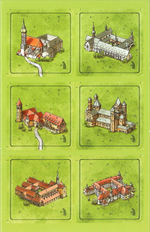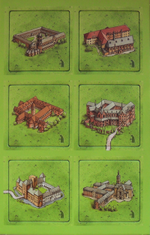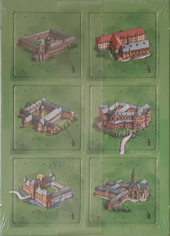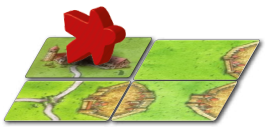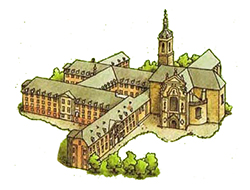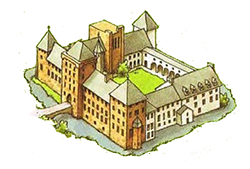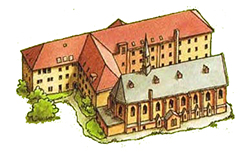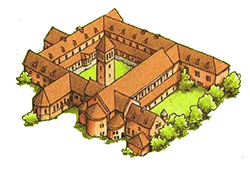Monasteries (1st edition)
 |
You are reading rules for this design of tiles. |  |
 | Open following rules if your tiles looks like this tile. |  |
| If your tiles have different design, then choose game from Spin-offs. |  |
General info and comments
Monasteries in Germany (Klöster in Deutschland) was originally released by Hans im Glück in 2014.
Monasteries in the Netherlands & Belgium (de Kloosters) was originally released by 999 Games in 2014. Hans im Glück also released a version with some changes to the graphics and identical rules in 2016.
The two Monasteries expansions are independently packaged expansions. The rules for Monasteries in Germany and Monasteries in the Netherlands & Belgium are identical.
Contents
- 6 new land tiles (Monasteries in Germany)
- 6 new land tiles (Monasteries in the Netherlands & Belgium)
Rules
Preparation
Remove the “original” cloister tiles from the base game and return them to the box. [1] Mix the six new Monastery tiles in with the rest of the game tiles.
Placing a tile
The tiles of this expansion are placed following the basic rules of Carcassonne.
Deploying a follower
If a player draws one of the German Monastery tiles, he places it according to the normal rules. He then has two options when deploying a follower on the monastery: [2] [3] [4]
- As a Monk: In this option, the monastery is treated like a cloister in the base game, and all the normal scoring rules remain the same; or
- As an Abbot: In this option, the follower is considered an abbot of the monastery. To emphasize this, the player stands the follower on its side to signify that the monastery will be scored differently than a cloister. The monastery scores only at the end of the game. [5] [6] Therefore, the abbot remains on the tile during the game and does not return to the player.
Scoring
Scoring a monk
A follower placed on a Monastery as a monk follows the regular scoring rules of Carcassonne.
Final scoring of an abbot
An abbot on a monastery is not scored until the end of the game. For his abbot, the player receives 1 point per tile present in the vertical column and horizontal row outward from the monastery. The monastery tile itself also scores 1 point. Any empty spaces in the monastery’s row or column interrupt the series of tiles that score for the monastery. [7]
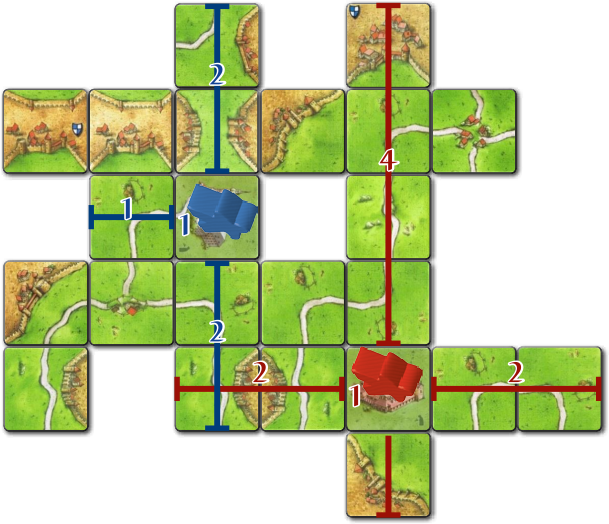
Note: For the sake of clarity, the figures in the additions correspond to the number of tiles in the column above, the row to the right, the column below, the row to the left and the monastery itself respectively.
Tile distribution
Monasteries in Germany
Monasteries in the Netherlands & Belgium
999Games edition (2014)
HiG edition (2016)
Monasteries in detail
Monasteries in Germany
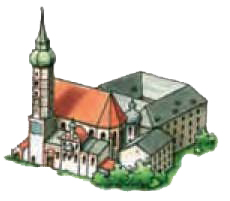
|
Andechs Monastery (Bayern) On the eastern shore of Lake Ammersee, Andechs Monastery, the oldest pilgrimage site in Bavaria, is located. It was founded in 1455 as a branch office of the Benedictine monks. The monastery is also known far beyond the borders of Bavaria for its beer. |
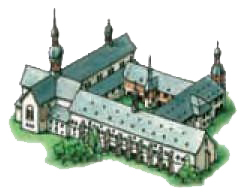
|
Eberbach Monastery (Hessen) The Eberbach Monastery is a former Cistercian abbey near Eltville. The monastery was founded in the 12th century, and with its Romanesque and early Gothic features, is one of the most important monuments in Europe. It gained worldwide fame as a filming location for the film adaptation of the novel "The Name of the Rose" by Umberto Eco. |
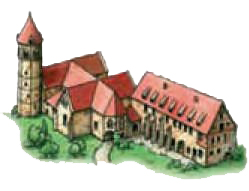
|
Lorch Monastery (Baden-Württemberg) Lorch, a former Benedictine monastery, is situated on a mountain ridge above the Rems valley, and is visible from far away. It was donated in 1102 by Duke Frederick I of Swabia and his family. The heyday of the Benedictine monastery was during the late Middle Ages. Even today, the charming monastery, complete with church, retreat, farm buildings and a garden, surrounded by a circular wall, is still completely intact, and attracts many visitors. |
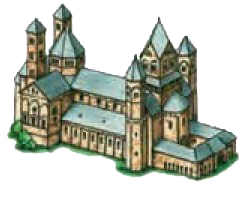
|
Maria Laach Monastery (Eifel/Rheinland-Pfalz) Founded in 1093 the Maria Laach is a high medieval monastery, located on the southwest side of Laacher Lake. A landmark of this Benedictine monastery is the 6-towered monastery church, the Laacher Munster. |
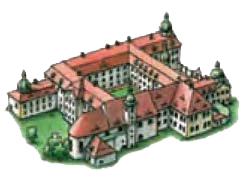
|
Marienthal Monastery (Sachsen) The monastery of St. Marienthal is the oldest convent of the Cistercian Order in Germany. It has continuously been in operation from its founding in 1234 until today. It is situated near Görlitz, on the border triangle of Germany, Poland and the Czech Republic. |
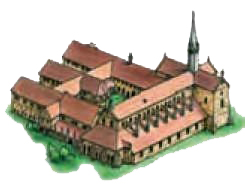
|
Maulbronn Monastery (Baden-Württemberg) The Maulbronn Monastery, a former Cistercian abbey which is now recognized as a World Heritage Site, is considered to be the most well-preserved medieval monastery north of the Alps. Founded in the 12th century, all styles and levels of development of the Romanesque period through the late Gothic period are represented here. |
Monasteries in the Netherlands & Belgium
Footnotes
For Icons explanation and licensing please visit Icons page.
- ↑
 As an alternative, the special Monasteries could simply be added to the regular tiles without removing the original cloister tiles. However, if only playing with the base game and no other expansions, this may be too many cloister/monastery tiles. (4/2014)
As an alternative, the special Monasteries could simply be added to the regular tiles without removing the original cloister tiles. However, if only playing with the base game and no other expansions, this may be too many cloister/monastery tiles. (4/2014)
- ↑
 These two options are available whenever a follower would be placed on the cloister: initial follower placement (including phantom), wagon movement, magic portal, flier, etc. (5/2014)
These two options are available whenever a follower would be placed on the cloister: initial follower placement (including phantom), wagon movement, magic portal, flier, etc. (5/2014)
- ↑
 Note that the special Monastery is only a single feature, even though it can be used two different ways. Thus, if it is occupied by a follower, one cannot place a Phantom there, drive the wagon there, or deploy a follower to it with a magic portal. (7/2014)
Note that the special Monastery is only a single feature, even though it can be used two different ways. Thus, if it is occupied by a follower, one cannot place a Phantom there, drive the wagon there, or deploy a follower to it with a magic portal. (7/2014)
- ↑
 If a second follower is placed on the special Monastery through use of the Flier, the player can choose to make the new follower either a monk or an abbot, regardless of the identity of the first follower there. However, if the special Monastery is already surrounded by 8 tiles, thus representing a completed cloister, the second follower must be an abbot. (7/2014)
If a second follower is placed on the special Monastery through use of the Flier, the player can choose to make the new follower either a monk or an abbot, regardless of the identity of the first follower there. However, if the special Monastery is already surrounded by 8 tiles, thus representing a completed cloister, the second follower must be an abbot. (7/2014)
- ↑
 Because an abbot scores only at the end of the game, and this monastery is never considered completed, a monastery with an abbot will not score points for a follower in a castle. (5/2014)
Because an abbot scores only at the end of the game, and this monastery is never considered completed, a monastery with an abbot will not score points for a follower in a castle. (5/2014)
- ↑
 An abbot cannot be involved in a challenge with a heretic on a shrine/cult place, as the two scoring mechanisms are entirely different (the abbot’s monastery is never completed, so the heretic would always win). (5/2014)
An abbot cannot be involved in a challenge with a heretic on a shrine/cult place, as the two scoring mechanisms are entirely different (the abbot’s monastery is never completed, so the heretic would always win). (5/2014)
- ↑
 When using special Monasteries, the vineyard bonus is applied to the special Monastery if the follower is placed as a monk and the feature is scored as a finished cloister. However, the vineyard bonus is not applied if a follower is placed as an abbot on a Monastery, as the abbot scores only at the end of the game, when the vineyard has no effect. (5/2014)
When using special Monasteries, the vineyard bonus is applied to the special Monastery if the follower is placed as a monk and the feature is scored as a finished cloister. However, the vineyard bonus is not applied if a follower is placed as an abbot on a Monastery, as the abbot scores only at the end of the game, when the vineyard has no effect. (5/2014)

